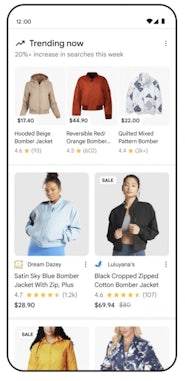Welcome to the latest blog from Impression on PPC & Paid Search industry updates, where we uncover the latest PPC trends to help you stay ahead of the curve. This month we’ve seen advances towards greater automation and streamlined experiences through the introduction of new features in Google Ads.
Keep reading to learn more about:
- Google to move away from keyword match types
- Google announces new features and tools for shoppers
- Google modifies ad extensions for a more efficient & informative experience
- Google announces Search to become more natural and intuitive
- Google introduces new ways for advertisers to create Video ads on YouTube
As usual, traffic light imagery is featured throughout to indicate the importance of each new update – red denoting a priority update, green representing a less important update and amber lying somewhere in the middle.
Google to move away from keyword match types

Our first, and possibly most important, PPC update this month comes courtesy of Benjamin W., who has highlighted one of the new features included within Google Ads’ latest limited beta.
Google has given marketers the opportunity to create broad match only campaigns, removing the ability to adjust and apply other keyword match types. Instead, it seems these campaigns will allow marketers to manage who is seeing their ads through ‘precise brand controls’, along with additional insights as to which keywords are offering the best results.
Whilst this feature is currently in its beta phase and gives advertisers the option as to whether they wish to implement it or not, Benjamin speculates that this is Google showcasing something they intend to make compulsory in the near future, with the possibility of removing keyword match types completely being on the horizon.
Ultimately, this seems to be another push from Google to increase the automation surrounding advertising and making further use of their machine learning capabilities, further highlighted by their statement that these campaigns will automatically improve keywords.
What does this mean for me?
For PPC as a whole, these proposed new changes are going to revolutionise the industry.
With Google only allowing marketers to create broad match only campaigns, it will make the need to manually target keywords more precisely obsolete, thanks to Google’s increased use of automation. That said, for advertisers this will make it difficult for them to navigate, considering most targeting will become more automated. This will certainly hold true for larger accounts, where Broad match does not always work, especially for small to medium sized advertisers, given the play of certain factors like budget, the assortment depth but also sufficient data.
In alignment with these changes, Google are to support advertisers with additional insights to help them have better brand control. However, it will remain interesting to see how the use of Broad will look in the ongoing future.
Google announces new features and tools for shoppers

As we swiftly approach the holiday season, Google has recently announced an array of new features aimed at consumers shopping online, in an attempt to offer a more streamlined and personalised shopping experience. Whilst the total number of tools Google is looking to implement sits at nine, we have highlighted a few of these changes to discuss.
Users will now be able to “shop the look” when searching for pieces of apparel through Google. This will not only show image recommendations of the exact item they were looking for, but also complementary items and where they can be bought.

In addition to this, trending products will allow users to discover the most popular options for their desired items at that given time – a feature that may arrive for U.S. users as soon as this fall.

Upon noticing how users prefer to interact with 3D images over static ones, Google is also set to expand upon its 3D technology by allowing both advertisers and merchants to upload a set of static images of sneakers which will then become a 360 degree spinning model, thanks to the help of machine learning.

Finally, the way users research a product before buying will become more streamlined with page insights, allowing for easy access to information such as product reviews and for users to opt into price drop updates.
What does this mean for me?
Overall, these new features are likely to provide consumers with a much better experience when shopping for specific products online, making the overall Google ecosystem more connected and streamlined.
However, the Google advertising landscape is bound to become much more complex from an advertisers perspective, especially with the upcoming holiday season. It is crucial that ads and assets are prepared for when these new features are released, as shoppers will always demand the best possible experience and those who fail to adapt might see their numbers fall substantially.
Whilst we are still unsure to what extent these new features will be customisable and how advertisers and merchants will be able to use them to their advantage, it is crucial to keep these changes in mind over the next few months.
Google modifies ad extensions for a more efficient & informative experience

Google has acknowledged just how important an engaging and streamlined experience is for consumers browsing online content, and noted that these expectations also apply to how they view ads. Key to this experience are Google Ads extensions, with Google noting that sitelink and image extensions are especially helpful in improving clickthrough rate.
In an attempt to facilitate how advertisers can deliver this improved experience, Google has changed the way ad extensions work, renaming them to “assets” along the way, as well as improving workflow and tools for reporting.

Rather than being an additional step towards the end of a campaign creation process, assets can now be created at the same stage as a Search or Performance Max campaign. This comes with more personalised recommendations, as the platform will now suggest the most appropriate assets depending on campaign objectives, along with previewing how these assets will look as part of your ads.
Measuring the performance of these assets has also been facilitated, with reporting across assets being unified in the “Assets” page under “Ads & assets”, providing an all-in-one hub for tracking performance.
What does this mean for me?
The change from ad extensions to assets may be confusing to many advertisers initially, especially those who have been used to the platform for so long. However, these changes are likely to make marketers’ lives easier in the long run by making ad creation a smoother experience than ever before.
Not only this, but strategic decision making surrounding these ads will also be simpler. Being able to access account, campaign and ad group level performance quicker, along with the new “combinations report” allowing you to see your assets alongside headlines and descriptions, optimising ads has never been easier.
Google announces Search to become more natural and intuitive

Search On returned again this year for its third annual search event outlining the latest tools and features Google are to implement. One of the announcements made was that Google is making search more natural and intuitive. This means that instead of text search, people will be able to find exactly the information they are looking for by combining images, sounds, text and speech just like people would do naturally.
Google announced that they will be making search more natural through multisearch – a new way for people to search using text and images simultaneously – similar to how a person might point at something and ask a friend. With the introduction of multisearch earlier this year, Google revealed that they will be expanding it to more than 70 languages in the next upcoming months.


As well as this, Google also announced that they will be taking this one step further with ‘multisearch near me’, allowing users to take a picture of an unfamiliar item like a dish or a plant and finding a local place like a restaurant or a plant shop.
What does this mean for me?
In essence, for users this way of searching will provide them with a better experience in how they find information online. The use of ‘multisearch near me’ will also help users find and connect with local businesses more easily, making search much more accessible.
However for PPC as an industry, this new transformative way of searching will make the advertising landscape more complex and harder for advertisers to navigate as users will be searching with fewer words and more images to find what they are looking for. Google has made it clear that the future of search is more visual, and as a result advertisers may be left at a disadvantage, possibly seeing lower traffic and higher CPC’s on their text search ads.
Therefore, it is crucial that advertisers focus efforts on managing assets and images and optimise best for user experience. For B2B, where it is difficult to portray what they do in an image, it is recommended to align images so that it provides a ‘sneak preview’ of what users can expect on their landing page to help entice users to click through and drive traffic to their website. However, it may require extra creativity in order to succeed and compete with these visual updates given tight restrictions on what’s allowed with image assets. Though, if Google wants advertisers to adopt these features, more support needs to be given like looser restrictions on image content for advertisers – especially for B2B advertisers.
Google introduces new ways for advertisers to create Video ads on YouTube

With a growing number of users, particularly amongst the Gen Z demographic, watching videos, Google have introduced new solutions and more creative guidelines to help advertisers make more effective vertical video ads on YouTube.
For example, Google has introduced a new reformatting solution, that reformats landscape video ads into square or vertical formats based on how someone is viewing a video on Youtube. This new machine learning technology detects important elements in the landscape ad – such as people, objects, logos, text and motion and breaks the video into distinct “scenes”, ensuring important elements show more centred and emphasised, as well as providing a more immersive view for users.

Alongside this, Google have also added 4 new, customisable vertical video ad templates, which can now be found in the video creation tool in Google Ads, located in the Asset Library. Following creative best practices for Youtube, these new added templates have been built with specific considerations for vertical viewing environments, such as pacing, music tracks and transitions, helping to make an impact on users.
What does this mean for me?
In terms of PPC, these new solutions to Youtube video ads give advertisers an opportunity to adapt content and strategies to consumers behaviours. By adding vertical video assets to video action, app and performance max campaigns, marketers can directly participate in the ‘shorts environment’ and drive better results in their campaigns. In fact, Google found that when marketers add vertical creative assets to their video action campaigns, they generated 10-20% more conversions on YouTube Shorts compared to campaigns that used landscape assets alone.
Furthermore, by using new reformatting solutions, it allows advertisers to get most out their creative assets in a short space of time- particularly if businesses do not have the dedicated resources to create multiple assets. The same goes for new ad templates, allowing marketers to create a vertical ad for a brand in minutes with just a few images and text. This new way of video ad creation ensures campaigns are well-positioned to benefit from the reach and improved performance of vertical video assets even if you don’t have the time or resources to make a custom video from scratch.
Look out for our next blog in November for more paid search industry updates to inspire your PPC strategy. If you want to talk about your business’ aspirations, get in touch!





